|
Data used in the analyses below (ecological condition, threat status, protection, distribution of activities, cumulative pressure from activities) are from the National Biodiversity Assessment 2018: Marine Realm Assessment. See the NBA 2018 website for access to the report.
|
EBSA Status Assessment and Management Recommendations
Ecological Condition, Threat Status, Current Protection and Key Features in the EBSA
Relevant Pressures and Activities (impact, extent) | Management Interventions Needed for the EBSA
Activity Evaluation Per Zone: Zoning Feasibility | Management recommendations for MPAs
Managament recommendations for MSP | Research Needs & Future Process
EBSA report download | Back to the SA EBSA status and management home page
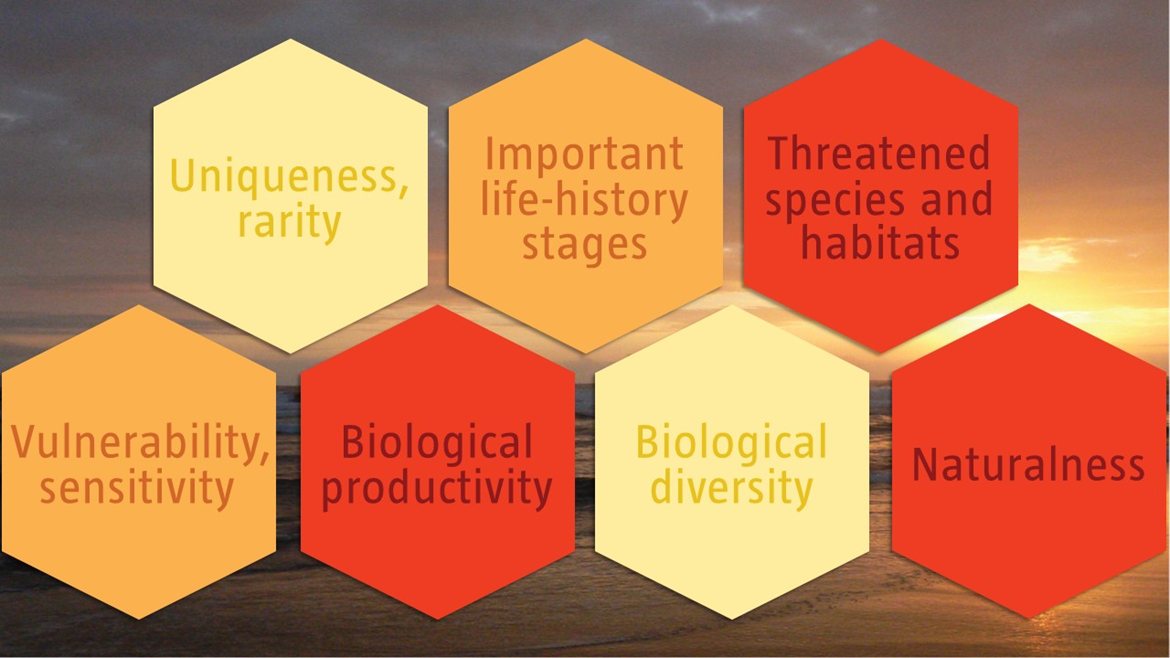
Namaqua Coastal Area is characterized by high productivity (due to upwelling) and community biomass along its shores. It is subject to relatively low pressures compared to other areas in the Northern Cape, and thus is an excellent place to protect portions of threatened ecosystem types that are in good ecological condition. There are three priority estuaries adjacent to the site. It is also important for coastal fish communities.
Click here for the full EBSA description
[Top]
Namaqua Coastal Area has a several features and threatened ecosystem types that need to be protected for the area to maintain the characteristics that give it its EBSA status. The criteria for which this EBSA ranks highly are: importance for threatened species and habitats, biological productivity and naturalness. There are 13 ecosystem types represented, of which mosaic and rocky shore ecosystem types contain fragile species that are especially sensitive to damage. Along with the adjacent estuaries, kelp forests also contribute to the nursery function of the EBSA and are sensitive to disturbance, although these can recover relatively quicker than some of the other more fragile and delicate species. The area is important for coastal fish, roosting and breeding birds, and resting sites for seals.

Namaqua Coastal Area proportion of area in each ecological condition category.
Given that the adjacent land is a terrestrial reserve, Namaqua Coastal Area is almost entirely in good ecological condition (98%), with fractions that are in fair (2%) and poor (<1%) ecological condition. Consequently, almost the whole EBSA comprises ecosystem types that are Least Concern (99%), with fractions that are Endangered (<1%) and Vulnerable (<1%).

Namaqua Coastal Area proportion of area in each ecosystem threat status category.

Namaqua Coastal Area proportion of area in a Marine Protected Area (MPA).
Protection of features in MPAs has been considerably expanded and strengthened following the proclamation of the Operation Phakisa MPA network, with the EBSA area within reserves increasing from no protection to 16%. The new MPA is the first and only MPA along South Africa’s west coast (north of Langebaan Lagoon and adjacent islands), and the only coastal reserve in the Namaqua ecoregion. Consequently, many of the represented ecosystem types are still poorly protected overall, although some are now moderately protected, and one is well protected.
Threat status, protection level and ecological condition of ecosystem types in the EBSA. Other key features are also listed.
|
Feature
|
Threat Status
|
Protection Level
|
Condition (%)
|
|
Good
|
Fair
|
Poor
|
|
Ecosystem Types
|
|
Cool Temperate Arid Predominantly Closed
|
EN
|
PP
|
6.4
|
89.2
|
4.4
|
|
Namaqua Exposed Rocky Shore
|
VU
|
MP
|
2.8
|
48.7
|
48.5
|
|
Namaqua Kelp Forest
|
VU
|
MP
|
16.6
|
50.2
|
33.2
|
|
Namaqua Mixed Shore
|
VU
|
MP
|
4.0
|
55.2
|
40.8
|
|
Namaqua Muddy Mid Shelf Mosaic
|
LC
|
PP
|
99.9
|
0.1
|
0.0
|
|
Namaqua Muddy Sands
|
LC
|
NP
|
99.7
|
0.3
|
0.0
|
|
Namaqua Sandy Inner Shelf
|
LC
|
MP
|
82.4
|
17.0
|
0.5
|
|
Namaqua Sandy Mid Shelf
|
LC
|
PP
|
99.3
|
0.7
|
0.0
|
|
Namaqua Very Exposed Rocky Shore
|
VU
|
MP
|
3.5
|
56.4
|
40.1
|
|
Southern Benguela Dissipative Intermediate Sandy Shore
|
LC
|
WP
|
52.8
|
41.9
|
5.3
|
|
Southern Benguela Intermediate Sandy Shore
|
NT
|
PP
|
29.0
|
55.6
|
15.3
|
|
Southern Benguela Reflective Sandy Shore
|
EN
|
MP
|
16.8
|
74.6
|
8.5
|
|
Southern Benguela Sandy Outer Shelf
|
LC
|
PP
|
100.0
|
0.0
|
0.0
|
|
Other Features
|
-
Three estuarine areas
-
Importance for coastal fish, including nurseries for commercially important species
-
Upwelling
-
Breeding and roosting sites for shorebirds and seabirds (e.g., African black oystercatcher, cormorants)
-
Seals
|
[Top]
-
There are 13 pressures present in this EBSA, of which shipping is the only one that covers the entire EBSA extent; mean annual runoff reduction follows closely in spatial overlap with the EBSA, and has the highest cumulative pressure profile (followed by shipping).
-
Key pressures in this EBSA that most directly impact the features for which the EBSA is described include: mean annual runoff reduction, mining (prospecting and mining), linefishing, invasive species, coastal disturbance (recreational activities that, for example, would disturb breeding, roosting or foraging birds) and subsistence harvesting. These activities tend to cover discrete portions of the EBSA, and will need to be managed particularly well in order to protect the nursery habitats, fish assemblages, and coastal (including intertidal) benthic communities, and birds for which this EBSA is recognised.
-
Eight of the 13 pressures each comprise <1% of the EBSA pressure profile, including: coastal disturbance, subsistence harvesting, oil and gas (exploration and production), recreational shore angling, kelp harvesting, tuna pole fishing, gillnetting, and west coast rock lobster harvesting.
-
Activities in South Africa that are not present in this EBSA include: abalone harvesting, beach seining, benthic (hake) longlining, coastal development, dredge spoil dumping, mariculture, midwater trawling, naval dumping (ammunition), oyster harvesting, pelagic longlining, ports and harbours, prawn trawling, shark netting, small pelagics fishing, south coast rock lobster harvesting, squid fishing, inshore trawling, offshore trawling, and wastewater discharge.

Map of cumulative pressure from all activities in the EBSA and surrounds. Darker reds indicate higher pressure intensity.
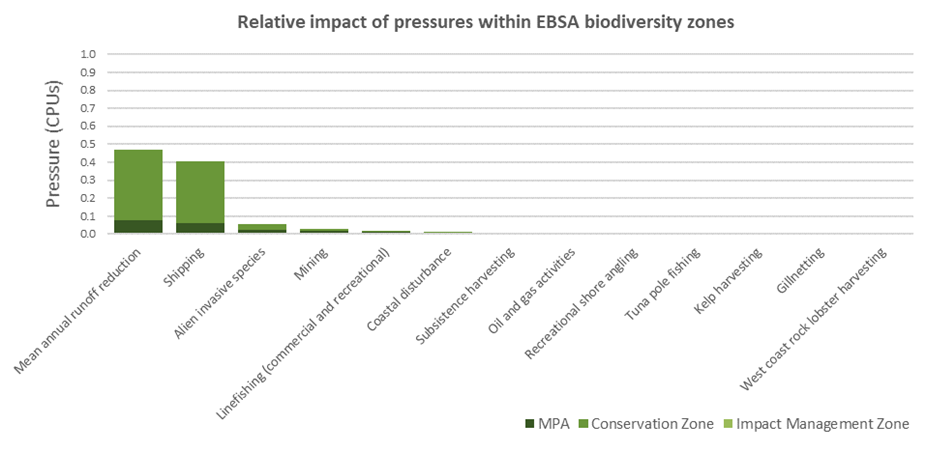
Pressure (in arbitrary cumulative pressure units, CPUs) summed for each pressure in the EBSA, per proposed EBSA biodiversity zone, ranked left (highest) to right (lowest) by the overall relative importance of pressures in this EBSA. Note that pressures from subsistence harvesting to wetst coast rock lobster harvesting each comprise <1% of the EBSA pressure profile.
[Top]
Improved place-based protection of EBSA features should be pursued. In support of this, the EBSA is divided into a Biodiversity Conservation Zone and an Environmental Impact Management Zone, both comprising several areas within the EBSA. The aim of the Biodiversity Conservation Zone is to secure core areas of key biodiversity features in natural / near-natural ecological condition. Strict place-based biodiversity conservation is thus directed at securing key biodiversity features in a natural or semi-natural state, or as near to this state as possible. Activities or uses that have significant biodiversity impacts are incompatible with the management objective of this zone. If the activity is permitted, it would require alternative Biodiversity Conservation Zones or offsets to be identified. If this is not possible, it is recommended that the activity is Prohibited. Where possible and appropriate, the Biodiversity Conservation Zones should be considered for formal protection e.g., Marine Protected Areas or Other Effective Area-Based Conservation Measures (OECM). The aim of the Environmental Impact Management Zone is to manage negative impacts on key biodiversity features where strict place-based measures are not practical or not essential. In this zone, the focus is management of impacts on key biodiversity features in a mixed-use area, with the objective to keep biodiversity features in at least a functional state. Activities or uses that have significant biodiversity impacts should be strictly controlled and/or regulated. Within this zone, ideally there should be no increase in the intensity of use or the extent of the footprint of activities that have significant biodiversity impacts. Where possible, biodiversity impacts should be reduced.
However, the biodiversity value of this EBSA is so high at a national level that it comprises a single Conservation Zone, which is partly covered by a new Marine Protected Area adjacent to the Namaqua National Park. The activities permitted within this MPA are not considered as part of the EBSA management recommendations because these are as per the gazetted regulations.
Proposed zonation of the EBSA into Conservation (medium green) and Impact Management (light green) Zones. MPAs are overlaid in orange outlines, with the extent within the EBSA given in dark green. Click on each of the zones to view the proposed management recommendations.
Protection of features in the rest of the Conservation Zone may require additional Marine Protected Area declaration/expansion. Other effective conservation measures should also be applied via Marine Spatial Planning (MSP) to ensure that the existing activities/uses are appropriately controlled to ensure compatibility of activities with the environmental requirements for achieving the management objectives of the EBSA Biodiversity Conservation and Environmental Impact Management Zones.
Based on the compatibility of sea-use activities with the management objective of the EBSA zone (see table below, from the sea-use guidelines of the National Coastal and Marine Spatial Biodiversity Plan), it is recommended for MSP that compatible activities are managed as General activities, which are those that are permitted and regulated by current general rules and legislation. Activities that are conditional are recommended to be managed as Consent activities, which are those that can continue in the zone subject to specific regulations and controls, e.g., to avoid unacceptable impacts on biodiversity features, or to avoid intensification or expansion of impact footprints of uses that are already occurring and where there are no realistic prospects of excluding these activities. Activities that are not compatible are recommended to be Prohibited, where such activities are not allowed or should not be allowed (which may be through industry-specific regulations) because they are incompatible with maintaining the biodiversity objectives of the zone. These recommendations are subject to stakeholder negotiation through the MSP process, recognizing that there will likely need to be significant compromises among sectors. It is emphasized, as noted above, that if activities that are not compatible with the respective EBSA zones are permitted, it would require alternative Biodiversity Conservation Zones or offsets to be identified. If this is not possible, it is recommended that the activity is Prohibited.
List of all sea-use activities, grouped by their Marine Spatial Planning (MSP) zones, and scored according to their compatibility with the management objective of the EBSA’s Biodiversity Conservation Zone (i.e., Critical Biodiversity Area, CBA). Activity compatibility is given as Y = yes, compatible, C = conditional or N = not compatible, with major activities that are present in the EBSA shaded in grey.

There are also some pressures on biodiversity features within the EBSA that originate from activities outside of these EBSA or beyond the jurisdiction of MSP. In support of maintaining the ecological integrity of and benefits delivered by the key biodiversity features, these other activities need to be appropriately managed by complementary initiatives.
Recommendations for other activities beyond the jurisdiction of MSP management to support securing key biodiversity features within the EBSA.

[Top]
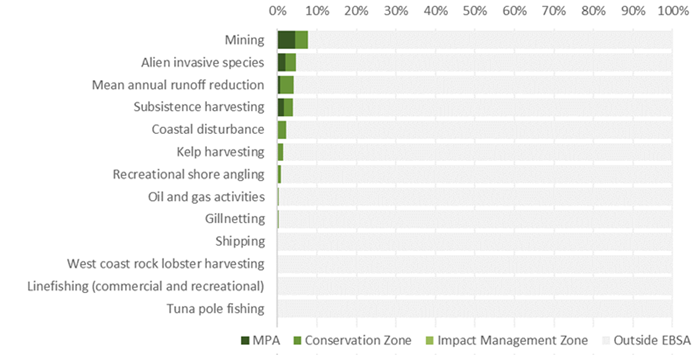
Proposed zonation of the EBSA, with the cumulative intensity footprint of activities within the EBSA (sorted highest to lowest) given relative to the national footprint of those activities to illustrate feasibility of management interventions.
The area has had significant historical value for South Africa’s mining industry, and although most areas are mined out, some activity still occurs in the area (13.5% of the national footprint), most of which is in the new Namaqua National Park MPA, and is recommended to continue as a Consent activity in the EBSA Conservation Zone. It is important that mining (prospecting and mining) is strictly controlled in the EBSA because the west coast of the country is heavily impacted by mining, and this is one of the few areas in this bioregion where the shores and associated biodiversity are still in fair ecological condition. Fishing and harvesting activities are accommodated in the EBSA, with subsistence harvesting, kelp harvesting, recreational shore angling, gillnetting, linefishing (commercial and recreational), west coast rocklobster harvesting and tuna pole fishing recommended to continue as Consent activities. Oil and gas (exploration and production) activities within the EBSA comprise a very small proportion of the national footprint, and are recommended to continue as a Consent activity. Shipping is recommended to continue in both the Conservation and Impact Management Zones under current general rules and legislation. Thus, in all cases, the EBSA zonation has no or minimal impact on the national footprint for the listed marine activities.
There are also several activities that are largely outside the EBSA but have downstream impacts to the biodiversity within the EBSA, e.g., from mean annual runoff reduction and coastal disturbance. The impacts should be managed, but principally fall outside the direct management and zoning of the EBSA. These existing activities are proposed as Consent activities for both EBSA zones, recognising that they should ideally be dealt with in complementary integrated coastal zone management in support of the EBSA. For example, investment in eradicating the alien invasive species could aid in improving the ecological condition of rocky and mixed shores, improving benefits for subsistence and recreational harvesting; and rehabilitation of degraded dunes and formalising access points could support improved habitat for nesting shorebirds, and enhanced benefits for coastal protection during storm surges. Similarly, improved estuary management through development of appropriate freshwater flow requirements and estuarine management plans can improve the ecological condition of the surrounding marine environment, in turn, improving water quality and safe conditions for human recreation.
Management recommendations for MPAs
Since the inception of the MARIMSA Project, protection has increased in the EBSA with the declaration of the Namaqua National Park MPA in 2019. This builds on existing protection already afforded by the land-based protected areas in the area. It is recommended that existing management is strengthened, and that full operationalisation of the new MPA is implemented, including a management plan, resourcing, and adequate staffing and law enforcement. Potential MPA expansion within the EBSA should be explored to ensure that the features for which the EBSA was described receive adequate protection. See Future Process below for more details.

Marine protected areas (MPAs) in the Namaqua Coastal Area EBSA. Land-based protected areas are also shown (from DFFE 2021).
[Top]
Management recommendations for MSP
Developing the biodiversity sector’s input to the national Marine Spatial Planning process
Following the initial management recommendations proposed for Namaqua Coastal Area, outlined above, South Africa iteratively developed a National Coastal and Marine Spatial Biodiversity Plan (NCMSBP; Harris et al. 2022a,b) that underpinned the Marine Biodiversity Sector Plan (DFFE 2022). The latter constitutes the biodiversity sector’s input into the national Marine Spatial Planning (MSP) process. The NCMSBP comprises a Map of Critical Biodiversity Areas and Ecological Support Areas (abbreviated to CBA Map), and a set of sea-use guidelines that indicate activity compatibility with the management objectives of each of the CBA Map categories. These two components form the basis for the proposed biodiversity zones and management recommendations for the Marine Area Plans. EBSAs are an integral part of the NCMSBP, and thus the Biodiversity Sector Plan. Therefore, these products informed the proposed zoning and sea-use guidelines for EBSAs in the MSP process.
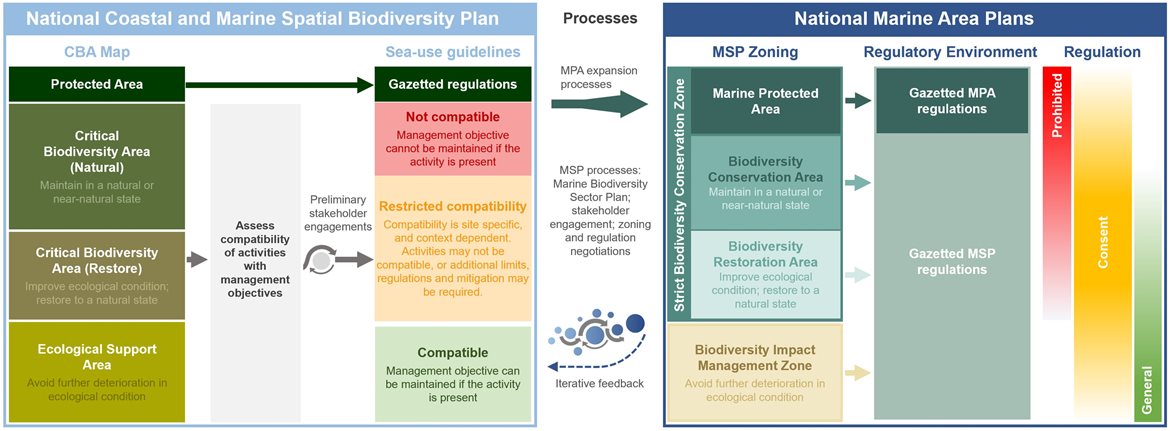
Schematic diagram illustrating that the National Coastal and Marine Spatial Biodiversity Plan will inform the Marine Area Plans through the Marine Biodiversity Sector Plan (DFFE 2022), and will be iteratively updated and refined based on feedback. The process for deriving the sea-use guidelines is also shown, indicating that it is based on an assessment of activity compatibility with the management objective of Critical Biodiversity Area (CBA) Natural, CBA Restore and Ecological Support Areas (ESAs). Marine Protected Area (MPA) expansion, focussing on CBAs, will also take place in a separate but related process. The outcomes of the Marine Spatial Planning and MPA expansion processes will be incorporated into the Marine Area Plans and will be fed back into future updates of the National Coastal and Marine Spatial Biodiversity Plan.
[Top]
Proposed Zones
The proposed biodiversity zones for the EBSA in MSP comprises two types: a Strict Biodiversity Conservation Zone; and a Biodiversity Impact Management Zone. The former has three sub-categories: Marine Protected Area; Biodiversity Conservation Area; and Biodiversity Restoration Area. All of these zones and sub-categories are found in Namaqua Coastal Area.
Namaqua National Park MPA is the only MPA in this EBSA. It is managed according to the gazetted management regulations for this MPA. The rest of the Strict Biodiversity Conservation Zone is primarily a Biodiversity Conservation Area, where the management objective of this zone is to maintain the sites in natural or near-natural ecological condition. A much smaller portion comprises a Biodiversity Restoration Area, where the management objective of the zone is to improve the ecological condition of the sites and, in the long term, restore them to a natural / near-natural state, or as near to that state as possible. As a minimum, avoid further deterioration in ecological condition and maintain options for future restoration. The rest of the EBSA is a Biodiversity Impact Management Zone. This is a multi-use area that may already be heavily impacted, but needs to be kept ecologically functional because it is still important for marine biodiversity patterns, ecological processes, and ecosystem services. Therefore, the management objective is to avoid further deterioration in ecological condition.
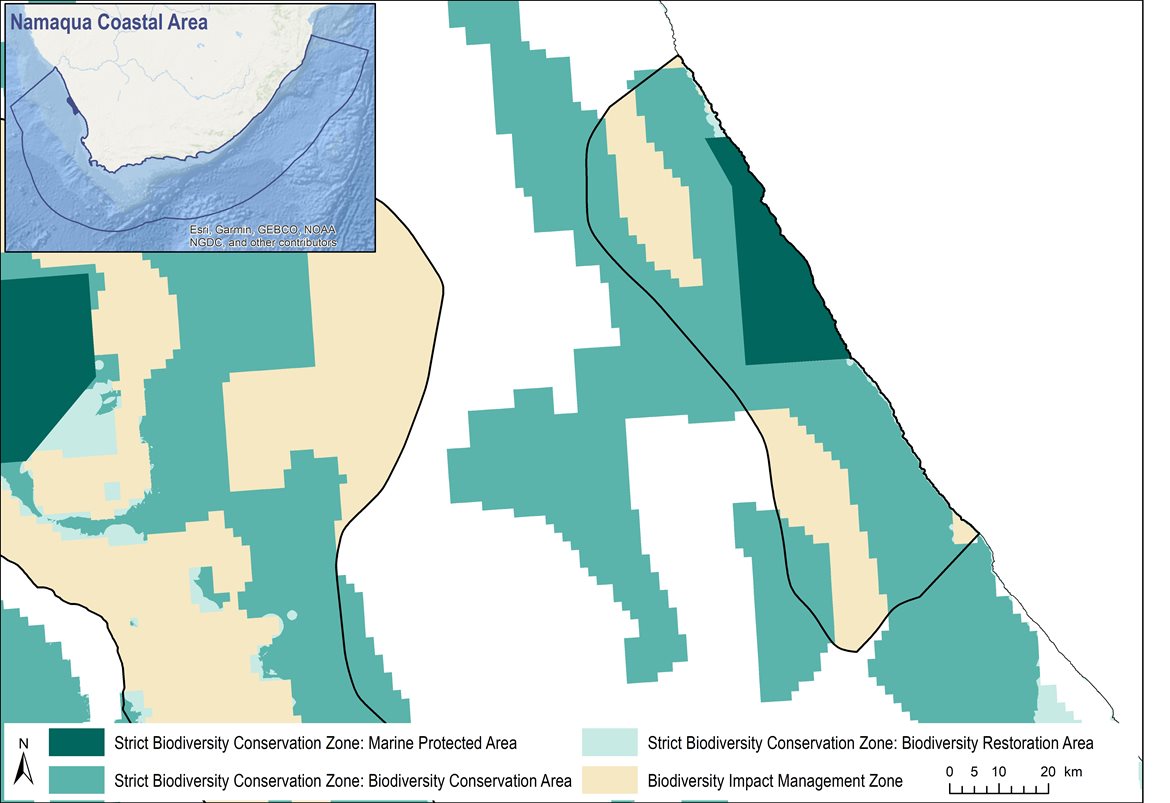
Proposed biodiversity zones for the Namaqua Fossil Forest EBSA for South Africa’s Marine Area Plans.
Proposed Sea-Use Guidelines
All sea-use activities were listed and evaluated according to their compatibility with the management objective of each of the proposed biodiversity zones. Where various aspects of an activity have a different impact on the environment, these were reflected separately, e.g., impacts from petroleum exploration are different to those from production. Activity compatibility was based largely on the ecosystem-pressure matrix from the NBA 2018 (Sink et al. 2019), which is a matrix of expert-based scores of the functional impact and recovery time for each activity on marine ecosystems (adapted from Halpern et al. 2007). Activities were then classified into those that are Compatible, Not Compatible or have Restricted Compatibility with the management objectives of each proposed biodiversity zone. This classification followed a set of predefined principles that account for the severity and extent of impact, similar to the IUCN Red List of Ecosystems criterion C3 (Keith et al. 2013). Some exceptions and adjustments were made based on initial discussions as part of the MSP process.
Sea-use guidelines for Namaqua Coastal Area. List of all sea-use activities, grouped by their broad sea use and Marine Spatial Planning (MSP) Zones, and categorised according to their compatibility with the management objective of Strict Biodiversity Conservation Zone: Biodiversity Conservation Area (SBCZ: BCA); Strict Biodiversity Conservation Zone: Biodiversity Restoration Area (SBCZ: BRA); and the Biodiversity Impact Management Zone (BIMZ). Activity compatibility is given as Y = yes, compatible, R = restricted compatibility, or N = not compatible. Strict Biodiversity Conservation Zone: Marine Protected Areas (SBCZ: MPA) are managed according to their gazetted regulations.
Proposed management recommendations for activities with each of the different compatibility ratings:
-
Compatible: Activities should be allowed and regulated by current general rules. Notwithstanding, there should still be duty of care, possibly requiring monitoring and evaluation programmes, to avoid unintended cumulative impacts to the biodiversity features for which this area is recognised.
-
Restricted compatibility: A robust site-specific, context-specific assessment is required to determine the activity compatibility depending on the biodiversity features for which the site was selected. Particularly careful attention would need to be paid in areas containing irreplaceable to near-irreplaceable features where the activity may be more appropriately evaluated as not permitted. The ecosystem types in which the activities take place may also be a consideration as to whether or not the activity should be permitted, for example. Where it is permitted to take place, strict regulations and controls over and above the current general rules and legislation would be required to be put in place to avoid unacceptable impacts on biodiversity features. Examples of such regulations and controls include: exclusions of activities in portions of the zone; avoiding intensification or expansion of current impact footprints; additional gear restrictions; and temporal closures of activities during sensitive periods for biodiversity features.
-
Not compatible: The activity should not be permitted to occur in this area because it is not compatible with the management objective. If it is considered to be permitted as part of compromises in MSP negotiations, it would require alternative Strict Biodiversity Conservation Zones and/or offsets to be identified. However, if this is not possible, it is recommended that the activity remains prohibited within the Strict Biodiversity Conservation Zone.
[Top]
Research Needs
There are no specific research needs for this EBSA in addition to those for all EBSAs.
Future Process
There needs to be full operationalisation and practical implementation of the Namaqua National Park MPA, including a management plan, staffing, and resources. There also needs to be full operationalisation and practical implementation of the proposed zoning in the national marine spatial plan, with gazetted management regulations following the proposed management recommendations outlined above. Possible MPA expansion within the EBSA should be explored, with relevant areas included into focus areas that can be considered further in a dedicated MPA expansion process with adequate and meaningful stakeholder engagement. Further alignment between land-based and marine biodiversity priorities should also be strengthened, e.g., through the cross-realm planning in the CoastWise project.
[Top]
References
DFFE, 2021. South African Protected Areas Database (SAPAD). Available at: https://egis.environment.gov.za/protected_and_conservation_areas_database.
DFFE, 2022. Biodiversity Sector Plan: Input for Marine Spatial Planning (MSP). Department of Forestry, Fisheries and the Environment, Cape Town.
Halpern, B.S., Selkoe, K.A., Micheli, F., Kappel, C.V., 2007. Evaluating and Ranking the Vulnerability of Global Marine Ecosystems to Anthropogenic Threats. Conservation Biology 21, 1301–1315.
Harris, L.R., Holness, S.D., Kirkman, S.P., Sink, K.J., Majiedt, P., Driver, A., 2022. National Coastal and Marine Spatial Biodiversity Plan Version 1.2 (Released: 12-04-2022). Nelson Mandela University, Department of Forestry, Fisheries and the Environment, and South African National Biodiversity Institute, South Africa.
Harris, L.R., Holness, S.D., Kirkman, S.P., Sink, K.J., Majiedt, P., Driver, A., in press. A robust, systematic approach for developing the biodiversity sector’s input for multi-sector Marine Spatial Planning. Ocean & Coastal Management.
Keith, D.A., Rodríguez, J.P., Rodríguez-Clark, K.M., Nicholson, E., Aapala, K., Alonso, A., Asmussen, M., Bachman, S., Basset, A., Barrow, E.G., Benson, J.S., Bishop, M.J., Bonifacio, R., Brooks, T.M., Burgman, M.A., Comer, P., Comín, F.A., Essl, F., Faber-Langendoen, D., Fairweather, P.G., Holdaway, R.J., Jennings, M., Kingsford, R.T., Lester, R.E., Nally, R.M., McCarthy, M.A., Moat, J., Oliveira-Miranda, M.A., Pisanu, P., Poulin, B., Regan, T.J., Riecken, U., Spalding, M.D., Zambrano-Martínez, S., 2013. Scientific Foundations for an IUCN Red List of Ecosystems. PLoS ONE 8, e62111.
Sink, K.J., Holness, S., Skowno, A.L., Franken, M., Majiedt, P.A., Atkinson, L.J., Bernard, A., Dunga, L.V., Harris, L.R., Kirkman, S.P., Oosthuizen, A., Porter, S., Smit, K., Shannon, L., 2019. Chapter 7: Ecosystem Threat Status, In South African National Biodiversity Assessment 2018 Technical Report Volume 4: Marine Realm. eds K.J. Sink, M.G. van der Bank, P.A. Majiedt, L.R. Harris, L.J. Atkinson, S.P. Kirkman, N. Karenyi. South African National Biodiversity Institute, Pretoria. http://hdl.handle.net/20.500.12143/6372.